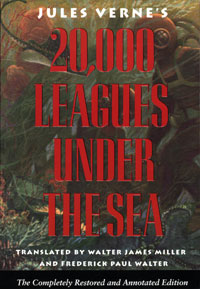Twenty Thousand Leagues Under the Sea
by Jules Verne
Paris: 1869-1870
The Definitive, Unabridged Edition
Based on the Original French Texts
Newly Translated and Annotated
by Walter James Miller
and Frederick Paul Walter
Naval Institute Press: Annapolis, Maryland, 1993
The Captain Nemo Line?
For many years I have suffered a curious failure of literary memory: When I think of the scene in Ayn Rand's Atlas Shrugged where Dagny and James Taggart argue over what to name the railroad that eventually becomes the John Galt Line, I always remember her as proposing to call it "the Captain Nemo Line." Of course, she makes no such proposal; for one thing, Atlas Shrugged is singularly free of allusions to other literary works. But somehow it always strikes me as an allusion that would have been entirely fitting.
Miller and Walter's translation of Twenty Thousand Leagues under the Sea helps show why this is so, much better than earlier translations of Verne did. In fact, Verne has suffered badly from careless and inept translators, as this version makes clear.
For a start, previous versions omitted over 20% of the French text, including important passages of technical detail, such as Captain Nemo's account of the batteries used on the Nautilus (Bunsen batteries, a type of wet primary cell actually used at the time, but operating at higher voltage due to the replacement of zinc with sodium in one electrode) and Professor Arronax's questions to Nemo about the thermodynamics of his power source.
Moreover, the English of previous translators was often not much better than their French, making it hard for readers to understand why anyone read Verne for pleasure. Happily, this translation has an excellent prose style that brings Verne's narrative and characters to life.
In the process, Verne's political themes emerge vividly. Consider, for example, his portrayal of the spirit of Ned Land, the harpooner, whom he makes a symbol of the American spirit of independence (despite Land's being a Canadian):
True to his nature, he spoke with great animation. He complained vigorously about being imprisoned in violation of his civil rights, demanded to know the legal basis for his detention, mentioned a writ of habeas corpus, threatened to take to court anyone holding him without due cause, ranted, gesticulated, shouted, and at last, by a very expressive sign, showed that we were dying of hunger.
Ned's rebellious spirit is one of the motors that drives Verne's story. Another is Captain Nemo's self-imposed exile from a world of political oppression, which leads him to say,
Exile and friendship"Professor ... I'm not what you call a civilized man. I am finished with society, for reasons I alone can appreciate, I don't obey its laws, and I suggest you never again refer to them in my presence."

Nemo in fact is one of the great characters of 19th Century literature. This novel isn't just a travelogue, despite the label voyages extraordinaires that Verne attached to his books; it's the story of Nemo's spiritual struggle, as his desire for the friendship of an intellectual equal such as Arronax conflicts with his recognition that Arronax is a willing citizen of the society from which Nemo has exiled himself and needs to return there. Calling it a love story would give the wrong impression, but it's a story of a passion for friendship as intense as the desire for sexual love.
Happily, Verne is now gaining more recognition and more accurate translations, and it can be hoped that his reputation will grown in proportion. This version, Miller's translation of From the Earth to the Moon, and the newly discovered Paris in the 20th Century show us the Verne we ought to have had all along, a man writing for adults.
And since I mentioned Ayn Rand at the beginning, I'll end by saying that it's hard to believe she wasn't influenced by Verne, even though she never avows his influence as she did Hugo's or Dostoyevski's. Many incidents in Atlas Shrugged have clear analogs in Twenty Thousand Leagues Under the Sea, from Ragnar Danneskjold's mysterious appearances and disappearances at sea to the terms of Dagny Taggart's confinement in Galt's Gulch, exactly like those of the confinement of Arronax and his companions on the Nautilus, and with the same justification. Nemo the inventor who discovered a new power source and Nemo the voluntary exile from human society would have been perfectly at home among Rand's heroes. Libertarians should not forgo the pleasure of his acquaintance.
© 2000 William H. Stoddard
First published in Prometheus, March 2000
Libertarian Futurist Society
Zvi Har'El's Jules Verne Collection
Note: "Nemo" in Atlas Shrugged
August 2002
It turns out that Atlas Shrugged does contain an allusion to Jules Verne, or at any rate a possible allusion. It isn't where I thought it is, in Dagny Taggart's conversation with James Taggart; it is a few pages later, in her conversation with Francisco d'Anconia asking him to help fund the John Galt Line. In response to his shock at the name Dagny asks sarcastically, "It sounds better than Mr. Nemo or Mr. Zero, doesn't it?"
The use of "Mr." rather than "Captain" slightly obscures the point, in keeping with Rand's general reluctance to acknowledge any influences, but surely that's the first association that would come to any reader's mind.
© 2002 William H. Stoddard
ReFuture at Troynovant
history of science fiction
& progress of fantasy
More by William H. Stoddard
| Troynovant, or Renewing Troy: | New | Contents | |||
| recurrent inspiration | Recent Updates | |||
|
www.Troynovant.com |
||||
|
Reviews |
||||
| Strata | Regions | Personae |
|
|||